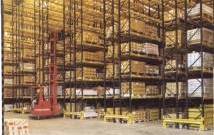Warehouse Storage Advice
Warehouse Environment
A tidy warehouse is the sign of a business that takes pride in its quality of service. If all of your products and processes have a place, you minimise the risk of damage and errors occurring and increase the efficiency of the business.
With the massive amount of differing types of shelving and racking available in today's marketplace, there is something to suit almost every conceivable requirement.
By being entirely independent from any particular manufacturer, ESE is perfectly placed to ensure you have the right product at the right price to suit your application.
A lot will depend on the types of product you are storing and whether you are manually loading the shelves or using mechanical handling. We have listed below some of the options available to you.
 If you are storing heavy and largely palletised equipment:
If you are storing heavy and largely palletised equipment:
- Adjustable pallet racking is the normal method, however, there are many different layout possibilities. Which one suits you will depend largely on the type of forklift you have and the range of products you store.
- The standard forklift requires aisles of around 2.7-3 m to work effectively and the height of racking is largely dependent on the capabilities of your truck and your building height.
- The best system for dense storage of differing product ranges is usually 'narrow aisle', which uses a forklift truck that is guided by rails in an aisle as narrow as 1.5m. You are able to access all pallets at all times but you require a unique type of forklift to do so.
- However, if you are storing bulk quantities of largely the same product, there are pallet racking based systems, such as 'drive in' and 'drive through', which allow for enormous density of storage with the forklift and driver actually entering the racking to store product. This does have one main drawback in that it has to be loaded from top down and back to front so that the last pallets in the system are normally the first pallets out.
- There are many other options available, such as standard pallet racking, push-back racking and even a rack clad building system that allows the racking to form the structure of the actual building.
If you are storing medium sized non palletised equipment:
- There are frame and beam clip together systems available, like Longspan and Widespan, that typically have galvanised or chipboard shelf panels and can hold up to 700 kg per level. These types of racking are available in numerous frame depths, from 1,200 mm to 450 mm, and beam widths from 3,000 mm to 1,200 mm.
- Beams clip into the frames and are adjustable in height. In addition, many options are available to cater for specific trade requirements, or 'add on' specials can be designed to suit your application.
If you are storing very bulky items or long lengths:
- There are systems such as fixed-arm or adjustable cantilever bar racks and vertical storage racks, which can be used to hold anything from a length of copper tubing up to several tons of plasterboard per level.
- Many standard sizes and configurations are available. Alternatively, racks can be designed to suit your specific needs.
If you are storing light to medium goods and need better segregation between products:
- The system that will suit you best is partly dependent on your budget. If you want the most versatile system, that can also be used to form two-tier structures in order to maximise your available headroom, there are systems such as Euro Shelving that are Boltfree and extremely versatile, with endless options available.
- The budget end starts with Industrial Angle and Rolled Edge, which are traditional 'nut and bolt' systems, with many options and sizes available, which can typically hold up to 300 lbs (150 kg) per shelf level.
- Slightly more expensive, but with greater shelf capacity, is Just Shelving, which provides wider bays and clearer front entry, but is still very competitively priced.
Mobile Bases
All of the shelving and racking systems mentioned could be fitted onto 'mobile' bases to allow much greater capacity or to save space. They could also be built above and below a mezzanine floor or, in some cases, can form the 'mezzanine' within the racking system. This enables full use of your headroom, whilst ensuring all work can be easily carried out by employees without the need for steps or forklifts, and fully complies with the Health and Safety rules. The choice is yours!
If you have valuable items, or areas you wish to prevent unauthorised access to, you could also integrate one of the warehouse partitioning systems we offer, with the shelving/racking system design.
We also specialise in handling systems, from pallet trucks and platform trolleys to belt, overhead and roller conveyor systems.
 If you are storing heavy and largely palletised equipment:
If you are storing heavy and largely palletised equipment: